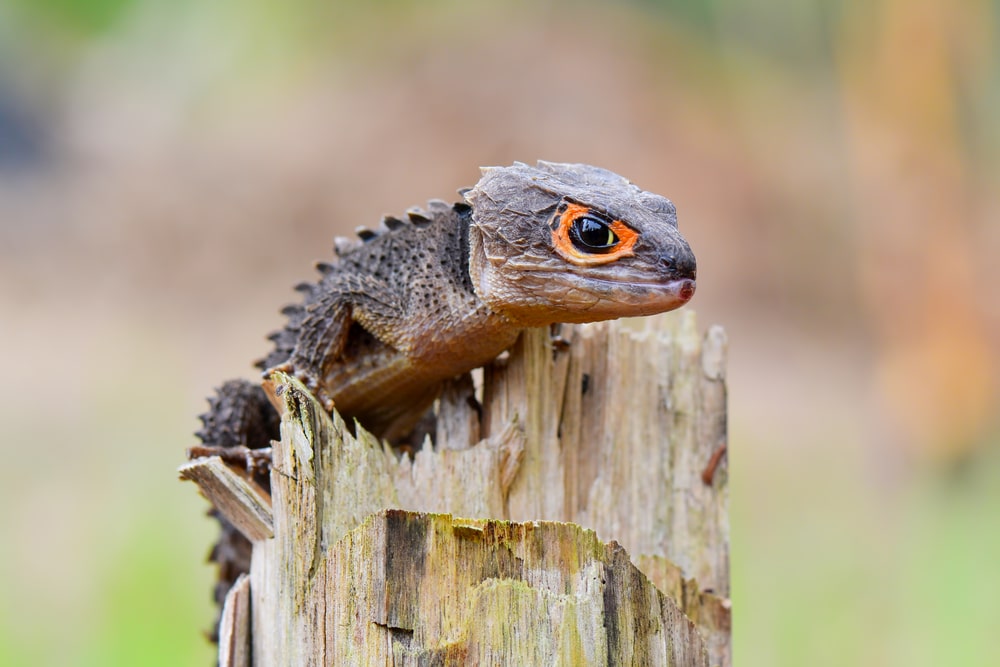Of the 8 known species, Tribolonotus gracilis and T. novaeguineae are the only two species commonly found in the pet hobby.
Dr. Nelly de Rooij was the curator of the Zoological Museum in Amsterdam when she published The Reptiles of the Indo-Australian Archipelago, Volume I, in 1915. Six years earlier, at the age of 26, Dr. de Rooij (sometimes spelled de Rooy) must have marvelled at the creature she first described in her publication as Tribolonotus gracilis, commonly known as the red-eyed crocodile skink. Dr. de Rooij also described Tribolonotus novaeguineae, a similar looking skink, which is commonly known as the casque-headed skink.
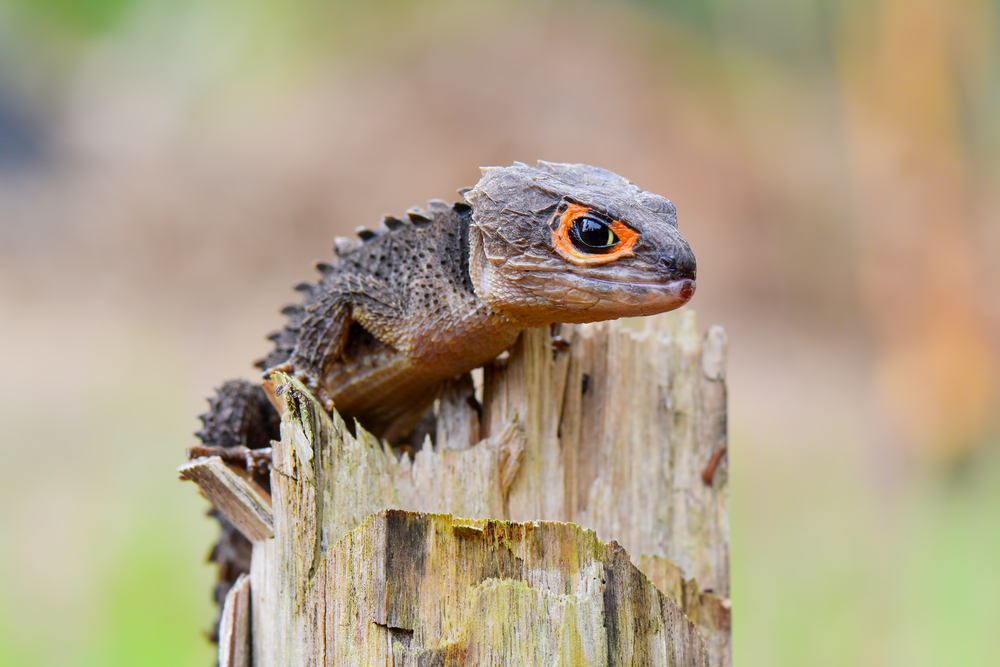
SHUTTERSTOCK/DWIYULIANTO
Red-eyed crocodile skinks are shy, crepuscular (active mostly at dawn and dusk) lizards.
There are eight known species in the genus Tribolonotus, which can be found from Irian Jaya and Papua New Guinea to the Solomon Islands. Tribolonotus gracilis (from Papua New Guinea, Admiralty Islands) and T. novaeguineae (Irian Jaya) are the only two species of Tribolonotus commonly found in the pet trade. The six other known species are T. annectens (New Britain, Bismarck Archipelago), T. blanchardi (Solomon Islands), T. brongersmai (Admiralty Islands, Bismarck Archipelago), T. ponceleti (Solomon Islands), T. pseudoponceleti (Solomon Islands) and T. schmidti (Solomon Islands).
Live imports of both T. gracilis and T. novaeguineae for the pet trade began in the mid 1990s, to Europe and North America. While red-eyed crocodile skinks are seldom imported, they are easily found living under forest debris, often near water. As deforestation of their native habitat occurs, making way for coconut plantations, red-eyed crocodile skinks have adapted to living on coconut plantations among piles of coconut husks.
The red-eyed crocodile skink has a strong, stout body and legs, and is dark brown dorsally and laterally, with a yellowish, cream-colored underbelly. It derives part of its common name, “crocodile skink,” from its four rows of dorsal, backward-curving keeled scales, each one tapering to a point, which resemble the dorsal scales of a crocodile. The flanks of T. gracilis have tubercles, whereas the flanks in T. novaeguineae have small keeled scales. In T. gracilis, the iris is dark brown and decorated by a bright reddish-orange semicircle of scales, while T. novaeguineae has only a small patch of light orange-to-yellow coloration at the front of the eyes. The length of both skinks is 8 to 10 centimeters (snout to vent), with a tail roughly the same length as the body.
Juveniles have the same body type and skin texture as the adults, but differ noticeably in their head and eye coloration. The head of a juvenile T. gracilis is a creamy brown color, the iris is light blue, and the eyes have no sign of the reddish-orange scales that are present in the adults. Mature coloration comes at about 6 months of age.
Red-eyed crocodile skinks are shy, crepuscular (active mostly at dawn and dusk) lizards. They are also capable of vocalizations when threatened or defending their offspring. Vocalizations of both male and female skinks have been recorded and analyzed. Interestingly, the analysis performed by Hartdegen, Ruston et. al (2001), shows there are differences between male and female vocalizations; thus, there seems to be sexual acoustical dimorphism in this species.
Red-Eyed Crocodile Skink Habitat
Areas where T. gracilis are found have an average daytime high temperature of 81 degrees Fahrenheit and an average nighttime low of 73 degrees, with humidity levels above 70 percent year-round. Red-eyed crocodile skinks are often found living under forest debris, which they dig into, creating nests between the debris and the soil, usually near water.
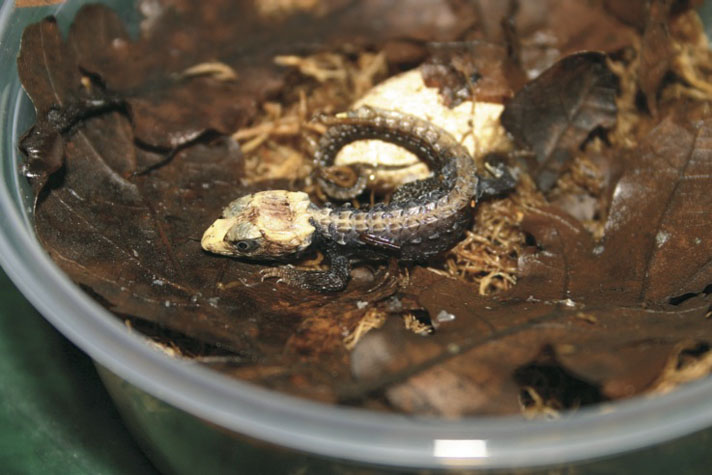
Web Wheeler
The head of a juvenile T. gracilis is a creamy brown color, the iris is light blue, and the eyes have no sign of the reddish-orange scales that are present in the adults.
The substrate is always moist, and although they are very capable climbers, they spend most of their time on the ground, searching for small worms, grubs and insects. Mark O’Shea observed red-eyed crocodile skinks colonizing piles of discarded coconut husks on coconut plantations on Kar Kar Island, Mandang Province, Papua New Guinea, raising hopes that this skink will adapt to human habitats as its own natural habitat disappears.
Red-Eyed Crocodile Skink Captive Husbandry
Red-eyed crocodile skinks are tropical lizards. They do best in glass terrariums with humidity levels between 70 and 90 percent and a temperature range of 73 to 81 degrees. Terrarium humidity and temperature control may be aided by employing glass terrarium tops, by the type and wattage of lighting used, and by the use of undertank heating pads with thermostatic control.
An adult pair may be comfortably maintained in a 3-foot-square aquarium containing 3 to 6 inches of substrate if live plants are used in the décor. The substrate used should promote evaporation and not encourage mold. My personal favorite is a layered substrate having a 1- to 2-inch upper layer of long-fiber sphagnum moss, topped with brown oak leaves and a wicking/drainage lower layer of hydroponic clay. If a shallow water level is maintained at all times in the bottom hydroponic layer, water will continuously wick up to the top layer, providing the terrarium with a constant, regulated supply of moisture and humidity. Layered substrates such as this also encourage colonies of edible micro-fauna to establish, providing a naturalistic habitat for the skinks to forage through.
A partially buried water dish for drinking and soaking should also be provided and cleaned regularly. Surprisingly, red-eyed crocodile skinks are able to hold their breath for quite some time under water, and they may submerge themselves in the water dish if startled.
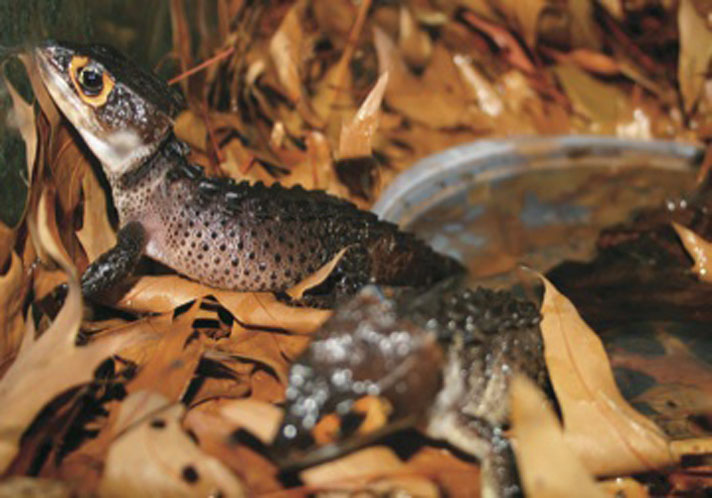
Web Wheeler
Tubercles line the flanks of T. gracilis.
For adult pairs, nesting/egg-laying sites may be constructed via indentations in the top substrate layer, which can then be filled with a mixture of peat moss and potting soil, and covered with cork bark. Coconut huts work well as hides for single adults or multiple juveniles.
Lighting is a topic that elicits several different opinions. Some keepers believe that a basking light is necessary, while others think that an ultraviolet (UV) light is required, or that both basking and UV lights are necessary, even though red-eyed crocodile skinks do not appear to bask in the wild. I have successfully kept, bred and raised red-eyed crocodile skinks using a 13-watt daylight compact fluorescent light, and by regularly feeding prey that is dusted with a calcium and D3 powder. None of my skinks have shown any sign of metabolic bone disease (MBD).
Although red-eyed crocodile skinks are crepuscular in the wild, captives will usually come out from their hiding spots if food is nearby. Dawn, dusk and during feeding are the best times to watch for the skinks to appear. A live earthworm placed near a skink’s hide will usually coax the skink out. Red-eyed crocodile skinks should be fed a variety of small insects, grubs and worms, which may include crickets, roaches, waxworms, mealworms, superworms and earthworms.
Although they rarely bite, red-eyed crocodile skinks are uncomfortable being handled, and they are best regarded as display animals. When grasped, they will often vocalize in distress and may suddenly try to escape, play dead or even drop their tails. They do, however, make stunning additions to display terrariums, where they are compatible with dart frogs, day geckos, crested geckos and other small frogs and lizards with habitat requirements similar to theirs.
Breeding Red-Eyed Crocodile Skinks
Red-eyed crocodile skinks are aggressive toward others of the same sex, especially males toward other males, but pairs and their young may all live within a range of a few square feet inside the same enclosure. Pairs of red-eyed crocodile skinks occupy the same nest, which they will aggressively defend, especially when an egg is present.
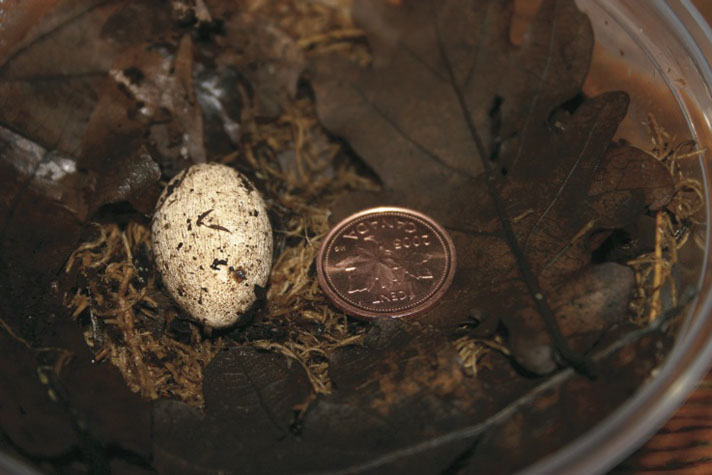
Web Wheeler
Single eggs are laid and buried inside a hide, slightly below the surface of the substrate. This can occur every week for five to six weeks.
Female red-eyed crocodile skinks have two working ovaries, but only the right oviduct is functional; therefore, eggs from the left ovary must migrate across the body cavity prior to oviposition. Up to six single eggs are laid, approximately six weeks apart, during the breeding (wet) season, which occurs in Papua New Guinea between December and March. In captivity, breeding can be initiated any time of the year by frequent misting and the resulting higher humidity.
Red-eyed crocodile skinks sexually mature around 3 to 4 years of age, and as they mature, they develop an orange-colored throat. The male is often larger and more robust than the female, but size is never a reliable indicator of sex. A more reliable technique to sexing is to photograph the underside of the skink through the glass bottom of a small, empty aquarium. Male skinks have grayish-blue, raised pores on the underside of the third, fourth and sometimes fifth toe of their hind feet. Males also have a rectangular section of four to six enlarged belly scales at the umbilicus, which I consider to be the most reliable indicator of sex in red-eyed crocodile skinks.
Most breeding activity probably takes place between adult pairs in their nest, as very little is currently known about this shy, secretive skink’s breeding behavior.
Conditioning them for reproduction should begin well before attempting to breed them. A healthy adult pair should be selected and given time to settle into their environment, which should have at least 3 square feet of floor space. The timing of the pairing, ideally, should coincide with the dry season in Papua New Guinea, which occurs from June to September. During this time, feed the skinks every other day with a variety of insects, grubs and worms, the staple of the diet being live crickets and earthworms. Prey should be gut-loaded with nutritious feed and dusted every second feeding with calcium and vitamin D3 supplements.
Want To Learn More?
Keeping And Breeding Crocodile Skinks
Provide several hiding spots, allowing the skinks to choose the ones they feel most comfortable in. Large coconut huts, or slightly curved pieces of cork bark, work well. If the pair are compatible, they will eventually choose to stay together in a single hide. Make an indentation, several inches deep, directly underneath the chosen hide and fill it with a loosely packed, slightly damp mixture of peat moss and potting soil for the pair to dig into.
During the dry season, the humidity should be maintained around 70 percent, with occasional misting if necessary. As breeding season approaches, increase the humidity to 85 to 90 percent by misting several times a day. Temperatures may fluctuate slightly during the day and night, but they should stay between 73 and 81 degrees, with warmer temperatures being associated with the breeding (wet) season.
As egg-laying begins, a single, leathery, 0.8-inch, oval egg is laid and buried inside the hide, slightly below the surface of the substrate, every five to six weeks, up to six times per breeding season.
Red-Eyed Crocodile Skink Ailments
Very little is currently known about Tribolonotus diseases and parasites, and apparently healthy, wild-caught animals have been known to suddenly die, even after years in captivity.
When purchasing red-eyed crocodile skinks, there are several things to look for. First, examine the skink for any external parasites, wounds and/or deformities. Second, look for eyes that are clear, shiny and alert. Dull-looking eyes are a sure sign of illness and/or dehydration. Lastly, look at the animal’s general demeanor. Red-eyed crocodile skinks should be very alert, but they may often remain motionless, try to escape, vocalize or even play dead when handled.
Upon arrival, all new imports should be singularly quarantined in small, sparsely decorated containers, such as a plastic sweater box with moist paper towel substrate, a shallow water dish and a coconut hide. A fecal exam should be done as soon as possible, looking for parasitic worms and other harmful micro-organisms. I use metronidazole (Flagyl) for protozoans, fenbendazole (Panacur) for round worms and nematodes, and prazaquantil for flatworms. If no parasites are found, the skinks can then be moved to a more permanent, fully decorated terrarium.
Metabolic bone disease, caused by a lack of calcium and/or vitamin D3 in the diet, is always a concern with captive reptiles because reptiles cannot utilize vitamin D3 without UV light, and calcium cannot be properly metabolized without adequate vitamin D3 present. Fortunately, MBD can easily be prevented by dusting food items, every second meal, with a mixture of calcium powder and vitamin D3 supplements.
Red-Eyed Crocodile Skink Care of Eggs and Young
Best hatching results are obtained by artificially incubating the eggs. Remove each egg from the nest and place it, half buried, into a slightly ventilated container filled with moist peat moss. Be careful not to reposition the egg from its original orientation in the nest. The ideal starting level of moisture in the incubation moss should be such that, when tightly squeezed, no more water will drip from the peat.
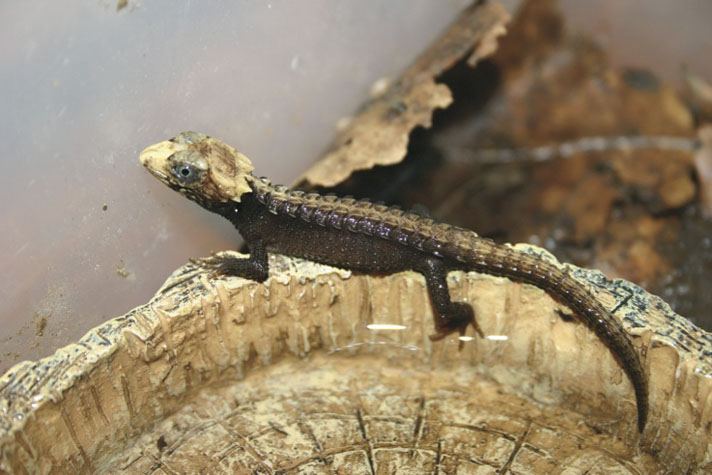
Web Wheeler
Juvenile skinks should be fed every day, and their food dusted with calcium/D3 supplements at every other feeding.
As long as the egg remains plump, no more water should be added to the incubation medium. Although some dimpling and sweating may occur naturally in eggs that are about to hatch, an egg that is indented is usually either dehydrated or dead, and a sweating egg is usually about to die or is already dead. Should it become necessary to add more water to the incubation container, add it to the hatching medium. Be careful not to get any water on the egg itself.
Egg incubation time varies from 65 to 85 days at 73 to 81 degrees. Just prior to hatching, the baby skink will make one or more small slits in its egg shell, from which it will emerge. Hatchlings are quite small at 6 to 8 centimeters and 3 to 5 grams. Within several hours of hatching, newborn skinks will be searching for food and hiding spots.
Small skinks should be fed every day and their food dusted with calcium/D3 supplements at every other feeding. Hatchling and juvenile skinks may be fed size-appropriate live prey, such as small crickets. In general, prey width should be no larger than the space between a skink’s eyes.
Red-eyed crocodile skinks are marvelous little animals that may live for at least 10 years in captivity, inspiring wonder in their keepers and in all those who are fortunate enough to observe them.
Web Wheeler is a website developer and pet industry professional with more than 40 years experience keeping and breeding reptiles, as well as tropical fish. His current breeding projects include freshwater angelfish, veiled chameleons and green tree pythons.

